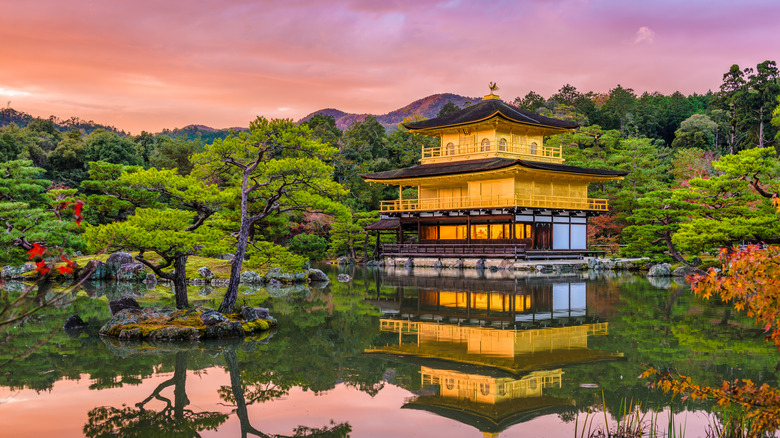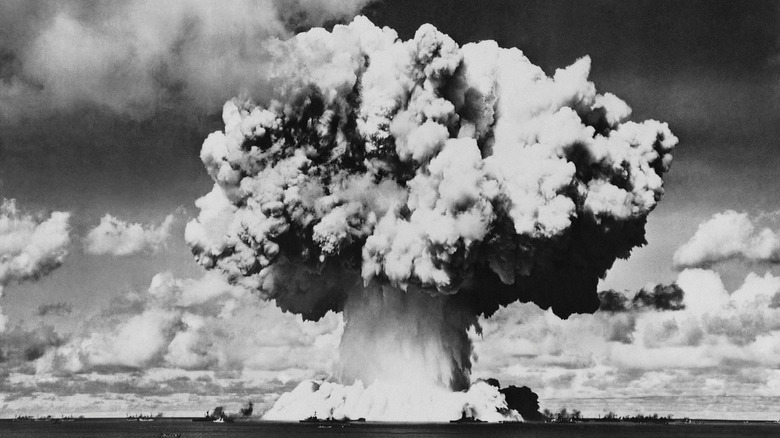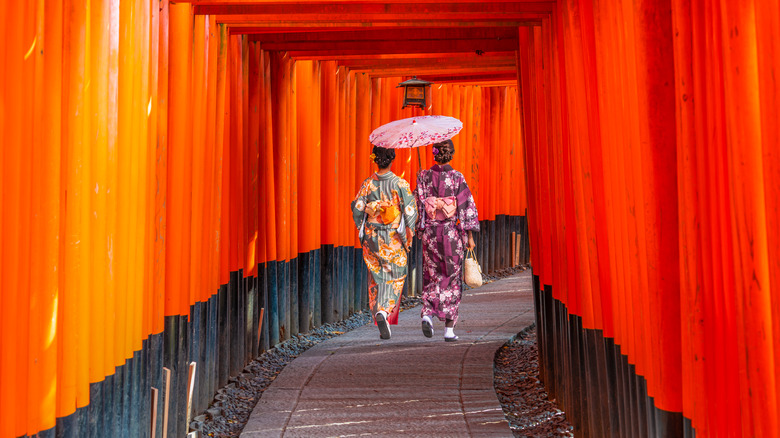Why Kyoto Was Spared From The Atomic Bomb, Leaving Nagasaki To Take Its Place
In the present, Kyoto is easily one of Japan's most popular tourist hot spots. The historical city is absolutely stuffed full of notable, big-name sites that international travelers and Japanese visitors can check off their bucket list as they wander: Kinkaku-ji (the gold temple, pictured above), Ginkaku-ji (the silver temple), Kiyomizudera (a giant mountain temple), Fushimi-inari (a pathway of red Japanese gates), and many more. In total, Kyoto contains a whopping 17 UNESCO World Heritage Sites. Besides these, it's just a treat to walk along Kyoto's old-timey streets. Folks planning on visiting either need to leave themselves multiple days if they want to see everything, or expect to be exhausted at the end of a single, nonstop day. But the shocking and horrifying truth is that all of it, down to the last shrine, almost got obliterated at the end of World War II.
As people know, the United States dropped two nuclear bombs on Japan at the end of World War II. According to History, the bomb Little Boy fell on Hiroshima on August 6, 1945, and Fat Man on Nagasaki on August 9. At most, the bombs and their twin flashes took the lives of an estimated 200,000 people across both cities. They left the cities ruined, irradiated wastelands, and changed the soul of Japan in ways beyond reckoning, to this very day. Emperor Hirohito announced the country's surrender a week later. However, not too many people know that it was almost Kyoto rather than Nagasaki that was obliterated.
Cities of strategic value
As National Geographic explains, the U.S. wanted to drop atomic bombs on Japanese cities of "high strategic value." They specifically sought to attack cities that were not already damaged by U.S. bombs in order to illuminate the sheer "destructive capacity" of their nuclear weapons. Further strategies included choosing cities whose borders spanned at least three miles and boasted large populations on which to inflict mass casualties and human suffering.
From April to June 1945, military personnel drafted a list of potential places. In the end, four cities met all three criteria: Hiroshima, Niigata, Kokura, and Kyoto.
Nagasaki didn't make the list because the city is very hilly, which would reduce the effectiveness of an atomic bomb blast. There was also a POW camp there. That being said, it was a major contributor to the Japanese military and contained Mitsubishi-Urakami Torpedo Works and Mitsubishi Steel and Arms Works. It was also a port and served as a World War II shipyard for the Japanese Navy.
In comparison, what "strategic value" did Kyoto offer? Practically nothing, militarily. But, as Japan's capital for over 1,000 years until 1868, it held nearly incalculable cultural and historical value. Ironically, this is why it was spared from bombing till then. As the BBC says, the U.S. also settled on Kyoto because 1,000,000 people lived there. A note from a meeting of military personnel also says that the people of Kyoto were "more apt to appreciate the significance of such a weapon as the gadget."
A last-minute target change
In the end, we have one person — U.S. Secretary of War, Henry Stimson — to thank for saving Kyoto from annihilation. As National Geographic says, Stimson personally removed Kyoto from the target list mere days before Little Boy and Fat Man struck. A hand-written note from July 24th — about two weeks before Fat Man fell on Nagasaki — reads "and Nagasaki" instead of Kyoto. At that moment Nagasaki pushed its way into fourth place on the U.S.' list of bombable cities, and Kyoto vanished from the list entirely. Rumor was the Stimson spared Kyoto because he'd visited it personally in the 1920s, and possibly even used it as his honeymoon spot. If so, then Kyoto's spell was in full effect even then.
At present, not only is Kyoto an intact, beautiful, preserved city, Hiroshima and Nagasaki have been long-since rebuilt as modern, thriving metropolises. Hiroshima is a heavy manufacturing city, as the Hiroshima Prefectural website says, and Nagasaki is a warm, beautiful, coastal location.
Survivors of the atomic bombings still exist. Their words, as Time records, include, "You are only given one life, so cherish this moment, cherish this day, be kind to others, be kind to yourself," and, "It would be ideal if we could all cultivate in us the ability to dignify each other instead of getting upset over our differences." Both cities contain monuments to peace and the dead: the Hiroshima Peace Memorial Park and the Nagasaki Peace Park.


